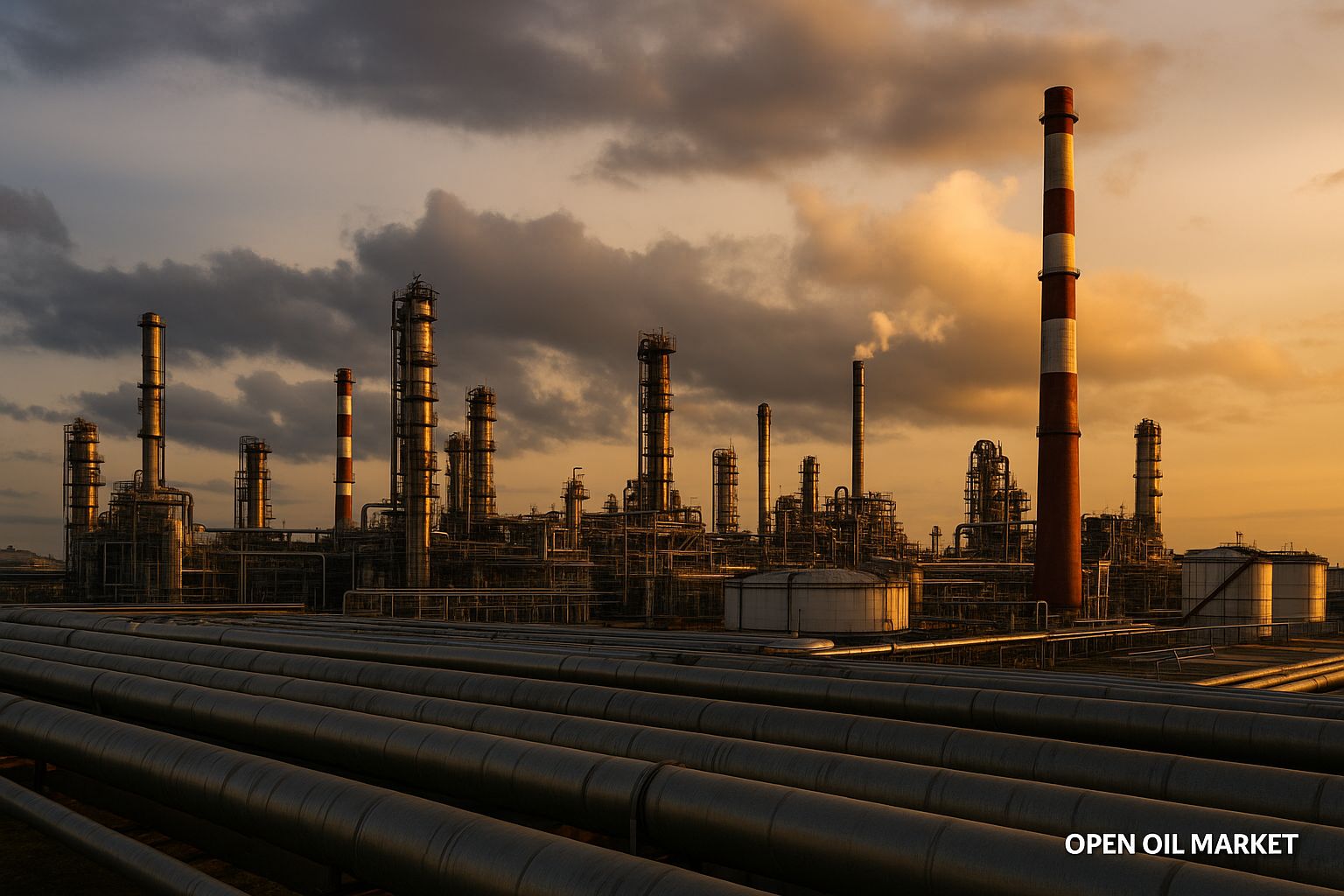
Current TЭK News as of August 10, 2025: U.S. Sanctions Pressure on India and China, Oil Price Stabilization, OPEC+ Policies, Export Ban on Oil Products in Russia, Rising Demand for Coal, and Energy Trends.
The latest developments in the fuel and energy complex (TЭK) as of August 10, 2025, are once again drawing the attention of investors and market participants. Washington is intensifying sanctions pressure on the largest buyers of Russian energy resources. Following measures against India, threats of tariffs are now being directed at China, increasing geopolitical tension. Against this backdrop, global oil prices, which experienced fluctuations, have ceased their decline and are demonstrating relative stabilization, as OPEC+'s actions and the outlook for negotiations impart cautious optimism. In Russia, a strict export ban on oil products remains in place to support the domestic fuel market. At the same time, Europe is rapidly replenishing its gas reserves ahead of winter, and demand for traditional energy resources, such as coal, is rising again due to high prices and the need for reliable energy supply. Below are the details of key news from the raw materials and energy sectors.
Washington Threatens India and China with Sanctions for Purchasing Russian Oil
The United States continues to sharply escalate pressure on countries purchasing Russian oil. President Donald Trump signed a decree on August 6 to impose additional import duties on goods from India, effectively doubling the tariff from 25% to 50%. These tariffs will take effect in 21 days and are a response to New Delhi's refusal to curtail its Russian oil imports. Previously, Washington openly threatened “three-digit” tariffs (100% and more) against nations continuing to buy energy resources from Russia, should Moscow fail to cease hostilities in Ukraine by the designated deadline of August 8. Although this deadline has passed, the U.S. signals that it is prepared to further tighten sanctions pressure on importers of Russian fuel.
Both India and China may be at risk of American sanctions. The U.S. Department of the Treasury has already stated the possibility of a 100% tariff on all exports from China to the U.S. as punishment for Chinese companies’ purchases of Russian oil. Paradoxically, Washington is simultaneously attempting to negotiate a new trade deal with Beijing, demonstrating a mixed strategy of "carrots and sticks." Nonetheless, the very fact of such threats exacerbates uncertainty in the global oil market, forcing energy companies to reassess their supply chains in light of potential new barriers.
Delhi and Beijing Reject Washington's Claims
India has responded emphatically to U.S. trade pressure, labeling its claims as unfounded. The country’s government has stated that it does not intend to reduce imports of Russian oil, as it is vital for the nation’s energy security. Traditional suppliers to India from the Middle East redirected most oil volumes to the European market following the onset of the Ukrainian crisis, compelling New Delhi to seek alternative sources. The Indian side emphasized that approximately 40% of its total oil imports now come from Russia, and these energy resources will continue to be purchased even after the imposition of American tariffs. Additionally, Indian authorities noted that the very Western nations condemning New Delhi still continue cooperation with Russia across many sectors, illustrating "double standards."
- National interests above all: India’s key priority is to ensure affordable energy prices for its population and economy. Purchasing Russian oil helps curb fuel price increases in the domestic market.
- The West trades with Russia: In New Delhi, it was reminded that EU countries still import gas, petrochemicals, fertilizers, and other resources from Russia, while the U.S. obtains some categories of Russian goods (such as nuclear materials). This undermines the demand to completely cease trading with Russia as unjust and hypocritical.
Simultaneously, Beijing has also rejected Washington's demands. The Chinese Ministry of Foreign Affairs stated that coercion and pressure will yield no results: China will defend its sovereignty and procure energy resources in ways that align with its national interests. Despite the threat of U.S. sanctions, China has made it clear that it will continue purchasing Russian oil. Thus, both India and China are notably resisting external pressure, intending to safeguard their economic security and fuel needs.
Oil Market: Prices Stabilized After Fluctuations
After several days of decline, global oil prices have halted their fall and even partially rebounded. By the end of this week, Brent crude prices returned to around mid-$60 per barrel (approximately $66–67), while West Texas Intermediate crude is trading in the $64–65 range. The improvement in market sentiment is attributed to several factors. First, fresh data from the U.S. Department of Energy indicated an unexpected reduction in commercial oil inventories by about 3 million barrels over the past week, signaling robust demand and supporting prices. Second, market participants are factoring in potential supply disruptions due to escalating sanctions: ironically, the tariffs imposed by Trump against India have pushed oil prices upward, as traders anticipate a reallocation of flows and additional supply risks.
However, the potential for price growth remains limited. One reason is the proactive policy of OPEC+, which the market has already factored in: the alliance of oil-producing countries agreed to increase production starting in September, and the expectation of additional volumes is moderately cooling the situation. Furthermore, concerns regarding a slowdown in the global economy and weakening demand in China prevent prices from surging sharply. Several analytical agencies have revised their forecasts, expecting Brent oil prices in Q4 2025 to average around $60–65 per barrel. Nevertheless, most experts believe that a deep price collapse will not occur: if prices approach critically low levels, OPEC+ countries may promptly cut supply to stabilize the market.
Sergey Tereshkin (Expert Comment for RBC): “Due to the slowdown in the global economy, the threshold of $70 per barrel will be the upper limit for Brent oil prices in the remaining months of 2025.”
OPEC+ Cautiously Increases Oil Production
OPEC+ member countries continue their policy of gradual oil production increase. In early August, several key participants of the agreement (including Saudi Arabia, Russia, the UAE, Kuwait, and others) announced an increase in the combined production quota by 547,000 barrels per day starting in September. This means an early termination of the voluntary cuts implemented at the end of 2023 (when the group of countries voluntarily limited production by a total of 2.2 million bpd). Now, thanks to a monthly production increase from April to August and the announced step in September, these restrictions are set to be completely lifted more than a year ahead of the originally planned schedule.
The market reacted calmly to the news of the supply expansion. The decision of OPEC+ was anticipated and already priced in, so it did not trigger upheavals. Moreover, the increase in quotas occurs amidst ongoing geopolitical tension, which softens the impact on prices. Experts note that it is crucial for participating countries to regain market shares lost during the restriction period while avoiding a price collapse. The alliance demonstrates unity and is focused on a gradual increase in supply in response to recovering demand. Further steps will be discussed on September 7 at the OPEC+ monitoring committee meeting, where the fate of the remaining voluntary restrictions amounting to 1.65 million bpd (extended until the end of 2026) will be assessed.
Russian Oil Products Market: Export Ban and Price Stabilization
The internal fuel market in Russia continues to enforce a complete ban on the export of certain oil products, primarily motor gasoline. The government has previously extended these restrictions to all producers and traders: from late July until August 31, 2025, the export of gasoline from the country is banned. This emergency measure aims to saturate the domestic market and curb the rise in prices at gas stations. According to the Moscow Fuel Association, the average retail price of AI-92 gasoline in Moscow reached approximately 59 rubles per liter by early August, while AI-95 was around 65 rubles per liter, significantly higher than the beginning of the year. Despite the imposition of the export ban, fuel prices at gas stations are gradually increasing, although the rate of price growth has slowed compared to June peaks.
To stabilize the situation, the government is implementing budgetary support mechanisms. In particular, oil refining plants (NPPs) are receiving compensation through the damping mechanism—subsidies that mitigate the discrepancy between high global prices and fixed domestic fuel prices. In July, the amount of damping payments reached approximately 60 billion rubles, helping to contain the increase in gasoline prices for end consumers. However, such expenditures burden the federal budget, especially given that oil and gas revenues in July yielded around 787 billion rubles—less than planned and the third consecutive month below expectations. The government is currently discussing the possibility of temporarily adjusting or suspending the damping mechanism if oil prices and currency factors continue to reduce export earnings.
Thus, balancing interests—keeping fuel prices low for the population while simultaneously ensuring budget revenues—remains a complex task for authorities and fuel companies. Market participants are closely monitoring the situation: oil companies are already experiencing pressure from increased taxes and sanctions restrictions, and any changes in subsidy or export regulation could impact their financial stability.
Gas Sector: Europe Stockpiles Reserves and Changes Routes
The European gas market is approaching the end of summer with solid stockpile indicators. Gas storage facilities (GSG) in the EU are filled to more than 72% of total capacity by early August, significantly exceeding average levels from previous years at this date. EU countries are actively injecting gas, striving to reach a target level of about 90% by November 1. High stock levels and a steady inflow of liquefied natural gas (LNG) from the U.S., Qatar, and several other exporters ensure relative price stability for gas in Europe: current exchange prices remain significantly below peak levels of 2022-2023.
The energy geography of gas supplies to Europe has changed significantly over the past year. Key shifts in routes and sources include:
- Stopped transit through Ukraine: Since January 2025, supplies of Russian pipeline gas through the Ukrainian GTS have been completely halted following the expiration of the contract between Gazprom and Naftogaz.
- South Corridor as the main route: The only operational route for Russian gas to the EU remains the TurkStream pipeline and its extension through Turkey and the Balkans. It transmits around 50 million cubic meters per day, partially compensating for volumes lost from northern routes.
- North Streams are out of service: The Nord Stream pipeline has been rendered inoperative following sabotage in 2022, while the Yamal-Europe pipeline is unused due to sanctions-related disputes between Russia and the West.
- Record LNG imports: The share of liquefied natural gas in the EU's imports has grown to a historic maximum. European LNG receiving terminals are operating at high capacity, replacing the volumes lost from pipeline gas.
Overall, the current situation in the European gas market inspires cautious optimism: the threat of fuel shortage this winter has been pushed back, although it is still too early to relax completely. The region continues to diversify sources and develop infrastructure for receiving and distributing gas to further strengthen its energy security.
Coal Energy: Rising Demand and a "Coal Renaissance"
The global energy sector is demonstrating a remarkable trend: after several years of decline, demand for coal is once again on the rise. Prices for thermal coal in Asian markets have been increasing for the third consecutive month. In July, the average cost of Australian coal reached ~$113 per ton—its highest since the beginning of the year—while coal from South Africa traded around $94 per ton. Price increases are fueled by steady demand from power stations in Asian countries (China, India, Vietnam, etc.), where economic growth is requiring reliable energy sources. Despite global decarbonization goals, many countries are forced to increase coal combustion in the short term to ensure stable electricity supply.
In the United States, a true "coal renaissance" is underway. In the first five months of 2025, coal-fired power generation in the U.S. rose by approximately 19% compared to the same period in 2024. According to the Energy Information Administration (EIA), about 25% of all electricity in the country is now generated from coal—its highest share in several years. This surge is driven by several factors:
- Expensive gas: The rising price of natural gas has made coal a more economically appealing fuel for generation, particularly for base-load power plants.
- Reliability of the energy system: To avoid outages, authorities and companies maintain coal plants on standby to compensate for the insufficient stability of renewable energy sources.
- Political support: The Trump administration has annulled several environmental restrictions and is encouraging fossil fuel extraction, including coal, as part of the U.S.’s energy independence strategy. These measures have provided additional impetus for the coal industry’s development.
Experts emphasize that while the development of renewable energy (wind, solar, etc.) continues to accelerate, it is impossible to completely abandon traditional fuels overnight. The International Energy Agency forecasts that global coal-based electricity generation will begin to gradually decline after 2025. However, the current situation highlights how challenging it is for energy systems worldwide to navigate the transition period without relying on "old" resources. For investors, this signals that oil, gas, and coal segments will retain significance in the coming years—provided there is modernization and an increase in the environmental sustainability of production.
Prospects for TЭK Investors
Collectively, Saturday’s news reflects a complex and multifaceted picture of the global TЭK. Geopolitical actions—such as U.S. sanctions pressure on buyers of Russian energy resources—introduce new risks and force the restructuring of trading flows. Simultaneously, market mechanisms continue to operate: OPEC+ balances supply increases with demand considerations, while consumers and businesses adapt to changing conditions, whether by seeking alternative suppliers or substituting energy resources.
In traditional sectors (oil, gas, coal), a temporary strengthening of positions is observed due to high prices and the desire to ensure energy supply stability—even in light of the strategic push towards a "green" transition. Investors and companies in the fuel and energy complex in Russia and worldwide continue to closely monitor these trends to make timely strategic decisions. The combination of flexibility and foresight in such an environment becomes the key to success for market participants—from oil and gas companies (including NPPs) to power generation and the renewable energy sector.




